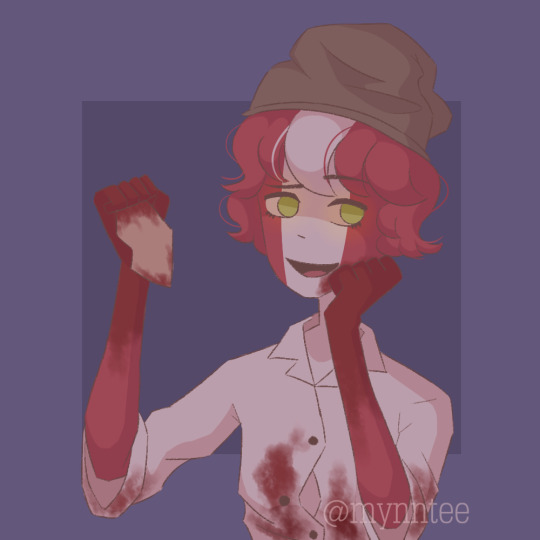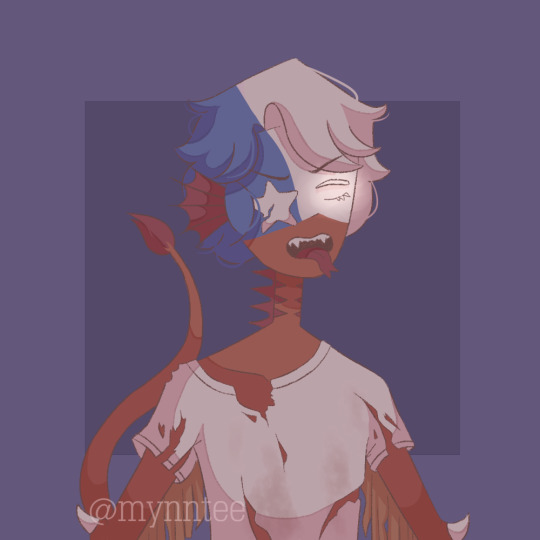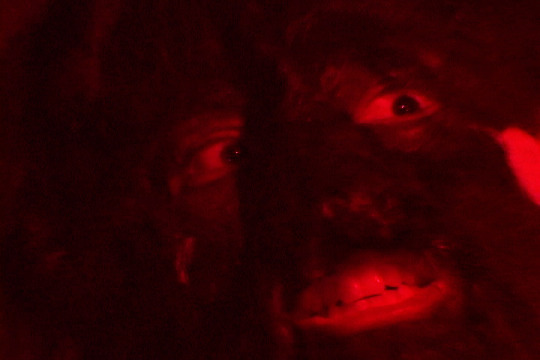#kharisiri
Explore tagged Tumblr posts
Text
I LOVE SACAMANTECAS SO MUCH. SOME OF MY FAVOURITE FOLKLORIC CREATURES. AND I LOVE SOUTH AMERICAN SACAMANTECAS THE MOST BECAUSE THEY HAVE SO MUCH TO DO WITH COLONIALISM AND THE LEYENDS NATIVES AND RURAL PEOPLE CREATED AROUND THEIR EXPLOITATION AND THEY ARE SUCH INTERESTING CREATURES
2 notes
·
View notes
Text

Strangers from the outside who look to steal the fat of people of the Andes. A humanoid more monstrous than many mythical beasts.
#BriefBestiary#bestiary#digital art#fantasy#folklore#legend#mythology#pishtaco#pishtaku#ñakaq#kharisiri#liki'chiri#andean mythology#andean folklore#human monster#monster#fat stealer
5 notes
·
View notes
Text
Der Pishtaku
Pishtaku, Pishtakuq oder Pishtaq (auf Ancash-Quechua), hispanisiert Pishtaco, in Südperu Nak'aq (auf Qusqu-Qullaw-Quechua) oder Nakaq (auf Chanka-Quechua), in Puno und Bolivien Kharisiri, Lik'ichiri oder Llik'ichiri (auf Aymara), ist in der andinen Tradition der Quechua und Aymara in Peru und Bolivien ein monströser, meist weißer Mörder, der den ermordeten Indigenen das Fett aussaugt.
Die Legende vom fettsaugenden Mörder Pishtaku oder Nak'aq ist in den peruanischen Anden insbesondere in den Regionen Ancash, Huánuco, Junín, Huancavelica, Cuzco, Ayacucho, Apurímac, Pasco und im Bergland von Lima lebendig. Die traumatischen Erfahrungen der Indigenen mit den spanischen Eroberern – ähnlich wie auch mit Vertretern der Macht bis in die Gegenwart – wurden in der Kolonialzeit bereits früh in Mythen verarbeitet. Der Pishtaku macht sich über Männer und Frauen her, die allein sind, und schneidet ihnen die Kehle durch, um ihr Fleisch in Form von Chicharrones zu essen und das Fett zu verkaufen. In anderen Erzählungen begräbt er seine Opfer, mitunter lebendigen Leibes, um die Erde zu düngen und den Gebäuden Festigkeit zu geben.
Der Pishtaku ist in der Regel ein Weißer oder auch Mestize, ein Mann mit Hut und Lederjacke, hoch zu Ross oder im Auto, vom Staat privilegiert und hochgebildet.
Mitunter kann er zu einer benachbarten indigenen Ethnie gehören.
Ricardo Palma beschreibt 1896 in der siebten Serie seiner Tradiciones Peruanas, wie Quechuas von Cusco in der Zeit um 1700 die dortigen Mönche vom Orden Padres Belethmitas oder Barbones (gegründet 1667) als Nacas (Quechua: nak'aqkuna) bezeichneten, die Indigene entführten und töteten, um ihnen Menschenfett zur Herstellung von Salben zu entnehmen.
In der andinen Tradition ist viel Körperfett ein Zeichen von Gesundheit, während Krankheiten mit Abmagerung und Fettmangel erklärt werden. Die Praxis der Conquistadores, Wunden mit dem Fett erschlagener Feinde zu behandeln, entsetzte die Indigenen.
In heutigen Erzählungen wird das Menschenfett für die Funktionsfähigkeit von Maschinen wie etwa Getreidemühlen oder Flugzeugmotoren, in anderen Fällen für pharmazeutische Produkte benötigt. Ebenso werden in Entwicklungshelfern, dem US-amerikanischen Peace Corps oder den Missionaren von SIL International Pishtaku gesehen. Hierzu gehört auch die Vorstellung, dass Kinder zunächst gemästet werden, damit ihnen später das Fett ausgesaugt werden kann.
Als Handlanger katholischer Geistlicher tritt der Nak'aq (hier: ñak’aq), ehemaliger Jünger Jesu, noch in den Jahren 2005 und 2007 in der Erzählung San Bartolomé ñak’aqman tukupun („Wie Sankt Bartholomäus ein Nak'aq wurde“) aus der Gegend von Chinchero bei Cusco auf. Für abgeliefertes Menschenfett – benötigt für Menthol und Medizin – erhält er von den Priestern des Konvents Santo Domingo Silber (oder Geld). Während durch die Landreform unter Juan Velasco Alvarado ab 1969 der vormalige kirchliche Großgrundbesitz den Indigenen gehört und die Tribute – Naturalien und Arbeit – für „Christus, die Seelen und den Priester“ abgeschafft sind, treiben die Nak'aqkuna weiter ihr Unwesen. Wem das Schicksal bestimmt ist, durch einen Nak'aq zu sterben, kann dem nicht entrinnen.
Die Angst vor dem Pishtaku wird von Eltern gegenüber ihren Kindern auch als Erziehungsmittel eingesetzt und so direkt an die nächste Generation weitergegeben.
Nach Einschätzung von Anthony Oliver-Smith, der in den 1960er Jahren in Ancash forschte, hat die Legende vom Pishtaku und das damit verbundene tiefe Misstrauen in die Fremden eine überlebenswichtige Funktion, um die indigene Gemeinde einig und auf Distanz von der realen Bedrohung durch die Weißen und Mestizen zu halten.
Der Pishtaco war auch die Vorlage für eine 2009 bekannt gewordene, aber schnell als Erfindung einiger Polizisten entlarvte moderne Legende, nach der eine als Pishtacos bezeichnete Bande von Serienmördern im Zeitraum seit den 1970er Jahren 60 Menschen ermordet haben soll, um ihr Fett an Kosmetikfirmen zu verkaufen.
0 notes
Text
this and old legends as well as primeval culture. i especially appreciate legends as a condensation of a peoples mass anxiety into a singular entity. kharisiri is a good example of this (but it is a post colonial legend)
whys humans turning into animals n shit the coolest shit in the entire fucking earth. tell me a cooler thing
1 note
·
View note
Text
Kharisiri

“Shugoran” © Verreauxi Aquilae. Accessed at their deviantArt page here
[The kharisiri, also known as the pishtaco, has a great story hook but no explicit description. My version was based in part on the T.E.D. Klein story “Black Man with a Horn”, illustrated above, with a dollop of @bogleech‘s Foetusaur. The flavor text draws heavily on the urban legends about fat stealing still common in Peru.]
Kharisiri
This hideous creature resembles a bloated human corpse, sickly-white in hue. The lower half of its face is dominated by a protruding trunk tipped in a circular mouth with multiple rings of teeth.
The kharisiri are a race of hideous shapeshifters who grease the divisions between rich and poor with stolen human fat. Kharisiri are attracted to places in which class or racial divisions are strong and tensions are high in order to prey on the weakest members of society in the guise of the strongest. The resultant distrust and chaos that arises gives the kharisiri great pleasure, but not so much as the wealth the kharisiri gains from its exploits. Not only to kharisiri sell their considerable knowledge to the highest bidder, but they also sell the fat they steal, mixed with the kharisiri’s secretions to make a paste capable of curing diseases and healing wounds.
Kharisiri hate to fight fair, and prefer to strike against single sleeping targets. Unlike most predators, they do not feed on the sick, young or elderly, preferring the misery caused by targeting healthy adults and draining their vitality. If discovered in its predations, a kharisiri uses its poisonous breath to disable as many targets as possible. Kharisiri are cowardly and will flee at the first opportunity from serious combat.
A kharisiri stands as tall as a man, but its corpulence pushes it to a weight of 300-400 pounds.
Kharisiri CR 9 XP 6,400 NE Medium aberration (shapechanger) Init +4; Senses darkvision 60 ft., Perception +17 Defense AC 20, touch 10, flat-footed 20 (+10 natural) hp 126 (12d8+72) Fort +9, Ref +4, Will +12 DR 10/slashing and magic; Resist acid 10, cold 10, electricity 10 Offense Speed 30 ft. Melee 2 claws +13 (1d8+4), bite +13 (2d6+4 plus grab) Special Attacks drink fat, poison breath, quiet bite Spell-like Abilities CL 9th, concentration +12 Constant—nondetection Statistics Str 19, Dex 11, Con 22, Int 18, Wis 15, Cha 16 Base Atk +9; CMB +13 (+17 grab); CMD 26 Feats Deceitful, Defensive Combat Training, Improved Initiative, Iron Will, Power Attack, Vital Strike Skills Bluff +19, Disguise +19 (+29 when using change shape), Intimidate +18, Knowledge (engineering) +16, Knowledge (religion) +19, Perception +17, Sense Motive +14, Stealth +15 Languages Common, Aklo, Undercommon, Draconic, Dwarven SQ change shape (humanoid, alter self), disgorge salve Ecology Environment urban Organization solitary Treasure double standard Special Abilities Disgorge Salve (Su) As a standard action, a kharisiri can vomit up a sticky paste that functions as a dose of restorative ointment (see Chapter 14 of the Pathfinder Core Rulebook). A kharisiri can use this ability once for every 5 points of Constitution drain it has dealt with its drink fat ability in the past 24 hours. Drink Fat (Ex) A kharisiri that pins an opponent or bites a helpless opponent drinks the fat of its victim, dealing 1d4 points of Constitution drain every round. A creature that has taken 4 or more points of Constitution damage from this ability is fatigued until the Constitution drain is healed; a creature that has taken 8 or more points of Constitution drain from this ability is exhausted until the Constitution damage is healed. A kharisiri heals 5 points of damage every round it uses this ability. Poison Breath (Ex) As a standard action, a kharisiri can breathe a 15 foot cone of invisible poisonous gas. It can use this ability even when it has changed its shape. A kharisiri can use this ability once every 1d4 rounds. Poison—inhaled; save Fort DC 20; frequency 1/hour for 4 hours; damage unconsciousness for 1 hour; cure 1 save. The save DC is Constitution based with a -2 racial penalty to the DC. Quiet Bite (Ex) A sleeping creature bitten by a kharisiri must succeed a DC 22 Fortitude save in order to wake up. The save DC is Constitution based.
37 notes
·
View notes
Note
a few minutes ago i was in the mood of making a tt & emh peruvian monster au… so i did (also omg i saw there was an anon who requested festejo a while ago and yooo ily, fellow peruvian!!!). ok so:
habit: the supay = the supay is basically the god of death and ruler of the underworld. he’s kinda the closest thing to the devil. he can transform into animals and smells like sulfur. he eats people and steals souls, usually by possessing someone to get close to new possible victims.
evan: the tunche = doesn’t have a known body or form, but it’s considered to be a man or bird. its whistle is a sign of his proximity. he’s not good nor evil, but a reflection of true human nature. basically, if you’re a bad person, he’ll kill you, but if you’re good then he’ll just remind you that one should not fear oneself. but here’s the cool part: if it ever whistles in top of someone’s house, it means they’ll soon die. it attacks by whistling and downright harassing the person, driving them insane or killing them due to the high frequencies of its whistle. (also, small groups of people think someone’s controlling him but that’s not considered true in most places)
noah/firebrand: the kharisiri = the kharisiri is anything and everything. it can transform into any living thing, ranging from animals to men. he’s thought to have made a deal with an evil being to obtain dark powers n stuff. he usually befriends people and when they go to sleep, he steals their body fat and blood to make itself stronger and protect itself. it’s rumored that it comes from a family that also made deals with that evil being, so they’re all kinda like it. (so then milo would be a kharisiri too, but i feel like he would reject the powers he’s been given cuz the kharisiris are kinda under control of that evil being n shit) ((also, noah would kinda be a normal human being and when he becomes firebrand it would be that he turns into the kharisiri??? the same with milo too? he’s a regular person but when he becomes mr scars he’s a kharisiri n shit?? lol idk)
the observer: the muqui/muki = the muki is a hobgoblin-ish creature who lives in the “uku pacha” (which means “the realm down under” in quechua). it’s usually found in mines and places near water, but you can also find it at the foot of your bed. he kills grown men to steal their skin or eat their food, but is mostly known for stealing unbaptized babies and hiding them under fig or banana trees to later turn them into mukis or use their bodies when they grow. fun fact: they also really like alcohol.
uhhhhh sorry if this is kinda long— (and yeah that’s all i have for now cuz i don’t remember any monsters that can properly fit the other guys, so when i go back to my place in a few days, i’m gonna whip out my peruvian myths book and update this)
- anon ryan <3
THESE RIGHT HERE ??? IN LOVE WITH THEM. BROBROBRO YOU SHOULD TOTALLY WRITE A FIC OR SOMETHING RELATED TO THIS !!! -Mod Dirk
#mod dirk answers#the anons in our ask box are so creative and i -#i love you guys so much thank you for sharing your ideas and stuff with me#ok ok im done bein all gushy
9 notes
·
View notes
Photo




deje este lugar olvidado aAaAaaA-
puede que me tiren esto por sangre pero me arriesgo
buenOm, para el mes de octubre me propuse a dibujar a países fusionados con algún ser mitológico de mi elección, iba a ser por 3 semanas pero ahora lo reduje a 2 por tiempo nnn-
En orden, son: Pishtaco, Kharisiri y Athrathrao. Pueden leer un pequeño resumen que escribí de estos en mi instagram, ñam
#countryhumans#countryhumanschile#chile#countryuhumansperu#peru#countryhumansbolivia#bolivia#vuelvo el finde a subir el de esta semana
11 notes
·
View notes
Text
Terror y cine fantástico en el 23 Festival de Cine de Lima

Breve historia del planeta verde, de Santiago Loza
Escribe: Luis Vélez.
Somos unos convencidos de la relevancia de los géneros de terror y fantasía en la historia y presente del cine, de su poder de representación y capacidad para ofrecer más de una lectura sociológica o psicológica. Es más, una buena parte del arte fílmico contemporáneo más interesante y logrado pasa por la aproximación, reivindicación o acercamiento a géneros clásicos como estos. Coincidentemente, el Festival de Cine de Lima ha programado una variedad de títulos pertenecientes o poseedores de elementos de estas vertientes. Revisémoslos.
Dentro de la Competencia de Ficción, en la brasileña Bacurau, de Kleber Mendonça Filho y Juliano Dornelles, acontece una extraña y formidable comunión de géneros que incluyen gore y ciencia ficción de serie B, nada ajenos a Mendonça Filho, director de conocida y dura cinefilia. Gracias a ello y en gran medida, Bacurau consigue erigirse como una historia distópica anticapitalista sobre la resistencia social. También en esta competencia hallamos la costarricense Ceniza negra, de la debutante Sofía Quirós. En ella, la adolescente Selva trasciende hacia lo metafísico en un ambiente de bosques y un contexto de búsqueda y crecimiento personal. Algo similar ocurre en otra opera prima, la brasileña Sin tu sangre, de Alice Furtado. Aunque mucho más experimental y de resultado desigual, en este filme hace su aparición La isla mágica, libro sobre vudú en Haití que traerá sus consecuencias.

Bacurau, de Kleber Mendonça Filho y Juliano Dornelles
La reciente sección “Búsquedas” del Festival de Cine de Lima, ahora en su segundo año, propone un panorama en el que el espectador explore nuevas formas narrativas del cine latinoamericano. Entre estas tendencias están las que establecen una alianza entre la experimentación narrativa y la incorporación de códigos del cine de género. Así, en Breve historia del planeta verde, de Santiago Loza (Argentina), asistimos a una road movie que es a su vez un drama de temática trans sobre la tolerancia, en el que un extraterrestre será la encarnación de las sensibilidades expuestas. Asimismo, en Vendrán lluvias suaves, el argentino Iván Fund (Argentina) plantea una premisa fantástica en la que los adultos no pueden despertar y los niños se lanzan a la aventura de andar solos.

Vendrán lluvias suaves, de Iván Fund
Como parte de la sección de homenaje a Claire Denis, vimos su más reciente película High Life. Denis, que ha transitado por diversos géneros sin dejar de lado sus sellos de identidad, asume el reto de la ciencia ficción futurista, desde una mirada de autor. Es un relato denso y asfixiante, de cuestionamientos bioéticos y alta carga sexual, sobre las posibilidades de la tecnología vinculadas a la propia condición humana. Otro relato futurista, aunque más inmediato, transcurre en Divino Amor, de Gabriel Mascaro, en un Brasil del 2027, tiempo en el que la sociedad es tomada por "orgías ritualísticas y cristianismo fundamentalista". Divino Amor se encuentra en la sección "Irresistibles" que también alberga el documental La venganza de Jairo, de Simón Hernández, crónica y tributo al maestro del terror colombiano Jairo Pinilla, cuyo amor por este género lo llevó a hacerlo con pocos recursos y mucha creatividad.

High Life, de Claire Denis
Militantes son también los realizadores peruanos que fuera de Lima y por más de veinte años vienen produciendo un cine de terror poblado de criaturas y apariciones fantasmales y demoníacas, extraídas de leyendas y mitos peruanos, en ocasiones con profundos sentidos alegóricos. La retrospectiva de este año en la sección Tierra en trance nos trae las películas: La maldición de los jarjachas (Ayacucho, 2002), de Palito Ortega Matute; Pishtaco (Ayacucho, 2003), de José Antonio Martínez Gamboa; El misterio del Kharisiri (Puno, 2004), de Henry Vallejo; Mónica, más allá de la muerte (Arequipa, 2006), de Roger Acosta; El Tunche (Junín, 2007), de Nilo Inga Huamán; Cementerio General (Iquitos, 2013), de Dorian Fernández-Moris; y La Cuda, la otra cara de la muerte (Cajamarca, 2013), de Dante Rubio. La muestra viene acompañada de un conversatorio con sus directores, moderado por Emilio Bustamante, reconocido investigador del tema. Información aquí.

La maldición de los jarjachas, de Palito Ortega Matute
Para finalizar este recuento podemos citar en la sección "La vuelta al mundo en 8 días" a la película fantástica de aventuras noruega La leyenda del rey de la montaña, de Mikkel Brænne Sandemose; la fantasía musical Yesterday, del británico Danny Boyle, y sobre todo el filme de terror y misterio La morgue, de Dennison Ramalho, que da cuenta del excelente momento por el que pasa el cine de género en Brasil, del que Ramalho es claro representante.

La morgue, de Dennison Ramalho
La mayoría de estos filmes tienen funciones y entradas a la venta estos días del festival, que va hasta el sábado 17. Toda la programación en su página web aquí.
0 notes